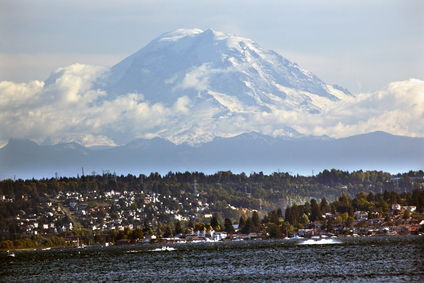By David Olmstead

Composite volcanoes are also called strato-volcanoes. It is a member of the volcanic landforms family. As the name suggests, they are composed of lava flows and pyroclastic materials of intermediate composition which includes volcanic ash, cinders, blocks and fragments of rock. It should not be confused with shield volcanoes or cinder cones because they not only differ in composition but also the shapes. Unlike the other two, composite volcanoes are deep sided near their summits.They can have an inclination of up to 30 degrees but their slopes decreases towards the base where they may be no more than 5 degrees.
Composite volcanoes assume different shapes. The most common ones include the following information;
1. Concave as witnessed in the Agna volcano.
2. A pyramidal e.g. the Stromboli volcano
3. Convex- concave as in the Vesavius
4. Some will form as multiple summits e.g. the Shasta.
5. Helmet shaped- Mount Rainier.
6. Perfect Cone shape of Mayon Volcano of the Philippines
Formation of composite volcanoes
They result from alternating layers of the composite materials like lava volcanic ash. A significant characteristic of the composite volcano is the process through which the magma from inside the earth’s surface transits to the top of the land. The volcano is built up by repeated accumulation of materials that erupts through the conduit and also increases in the sizes of lava and other materials. Normally volcanoes have have craters on their top which contains a central vent or a group of vents.
It is true that composite volcanoes erupt explosively and you will be impressed by this information.This is attributed to the viscous magma. When the magma comes to the earth’s crust, it results in clogging of the crater pipe thus causing the gas in the pipe to be locked up. This will cause pressure mount up and eventually violent eruptions occur.In some instances, the lava solidifies within fissures thus forming dykes.The dykes act as ribs thus giving strength to the volcano.
We want pictures and location of the lanforms around the world and we need your help. Click get started button below.
In Asia, China, India, Nepal, and Bhutan are home to one of the eight wonders of the world and one of the most beautiful mountains in the world, the Himalaya Mountains also called the Himalayas. Boasting as the world’s highest and most famous mountain peak, Mt. Everest. Within the verse of the ‘Kumarsambhava’, Sanskrit […]
Nature have provided us with fascinating landforms and features. The most often adored landforms are volcanoes. Like the perfect cone structure of Mayon Volcano in the Philippines or Mount Fiji in Japan, people look at their beauty and wonder with great appreciation to nature. Volcanoes are mountains with a very disastrous nature. Their only […]
Taal Volcano is the second most active volcano found in the province of Batangas. A complex volcano in the middle of Taal Lake and is often called an island within a lake, that is an island within a lake that is on an island as well as one of the lowest volcano in the […]
Mayon Volcano is one of the active volcanoes in the Philippines. Located in the southern part of Luzon about 473 kilometers (294 miles) from Makati Business District of the Philippines, Mount Mayon is the main landmark of the Province of Albay of Bicol Region. According to local folklore, the volcano was named after Daragang […]
The global temperature and weather is to a large extent a direct result of the sun’s effect to our planet. Together with the atmosphere and the rotation of the earth on its axis. The earth on which weather moves on has its own effect on the weather. The different landforms like mountains, volcanoes, plains, and the […]